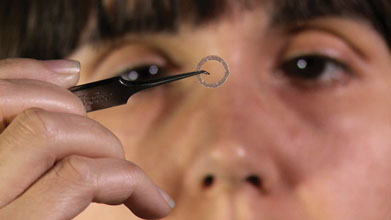
Engineers at the University of Sheffield have developed a new technique for delivering stem cell therapy to help the natural repair of eyes damaged by accident or disease.
In research published in Acta Biomaterialia, the team described the method for producing membranes that mimic the structure of the eye to help in the grafting of stem cells to treat corneal damage.
Using microstereolithography and electrospinning techniques, they have been able to make a disc of biogradeable material, which is loaded with stem cells and fixed over the cornea. The disc has an outer ring that contains niches or pockets, like those found on the rim of a healthy cornea, into which stem cells taken from the patient's healthy eye are placed. They added that the small pockets helped cells to group together and acted as a useful reservoir of daughter cells so that a healthy population of stem cells could be retained in the eye.
Register now to continue reading
Thank you for visiting Optician Online. Register now to access up to 10 news and opinion articles a month.
Register
Already have an account? Sign in here
